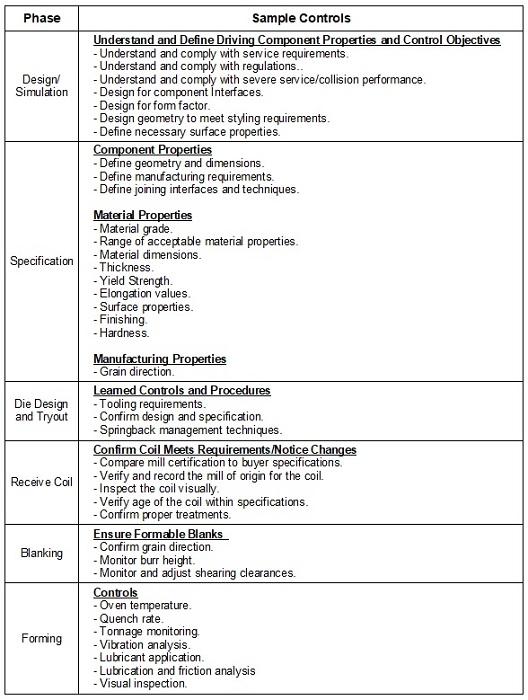President
- FMA
- The Fabricator
- FABTECH
- Canadian Metalworking
Categories
- Additive Manufacturing
- Aluminum Welding
- Arc Welding
- Assembly and Joining
- Automation and Robotics
- Bending and Forming
- Consumables
- Cutting and Weld Prep
- Electric Vehicles
- En Español
- Finishing
- Hydroforming
- Laser Cutting
- Laser Welding
- Machining
- Manufacturing Software
- Materials Handling
- Metals/Materials
- Oxyfuel Cutting
- Plasma Cutting
- Power Tools
- Punching and Other Holemaking
- Roll Forming
- Safety
- Sawing
- Shearing
- Shop Management
- Testing and Measuring
- Tube and Pipe Fabrication
- Tube and Pipe Production
- Waterjet Cutting
Industry Directory
Webcasts
Podcasts
FAB 40
Advertise
Subscribe
Account Login
Search
Using gatekeepers to manage manufacturing production results
Monitor, sensor, and analysis controls help find quality problems before it’s too late
- By Bill Frahm
- November 21, 2019
- Article
- Manufacturing Software

Controls such as monitors, sensors, and analysis can help manufacturers decide if a product is ready to enter the next phase of production to ensure a quality end result. Getty Images
Your process to design and form components is only as good as your efforts to manage it. From design to customer delivery, effective processes need controls. Controls are the barriers that confirm the quality of objects before they can pass to the next task. Your controls are your best defense against defective product and inefficient process. Controls should also offer measurements that help you identify the root causes of defects and improve your processes.
Decisions, Decisions
We make control decisions daily. Do I feel well enough to go to work? What should I make for dinner? How do I drive to work? Each of these decisions is based on information and experience.
Your choice of route to work may depend on radio traffic reports, navigation software, or how your drive went yesterday. Your favored sources of information enable you to choose the optimal route to work. The quality of your traffic decision depends on our understanding of traffic flows and the reliability of available information. Perhaps a rolling patching crew is less disruptive than two miles of a shut-down lane. Maybe your navigation software provides more current and reliable information than news radio. You employ experience, knowledge, and information to decide.
This is the same decision process you should use in manufacturing components. Each task in your design and manufacturing process has requirements for the properties of incoming information and materials. Likewise, each task’s output must meet its specifications. This is called “value add.”
When a control fails or is inadequate, forming failure and scrap can result. If controls fail to capture inadequate product, the result is dissatisfied customers and warranty claims. Building quality product efficiently requires knowledge, experience, and information. Likewise, internet of things implementations require you understand the quality of your information, know the fundamental controls of your processes, and have the experience to respond to events effectively.
The joy of manufacturing is in converting an abstraction (an idea, a set of performance requirements, and drawings) into a functional physical product. Design begins by defining some of the following:
- Service requirements
- Regulatory requirements
- Severe service/crash performance
- Interfaces
- Style
- Form factor
- Geometry
The remainder of the process, from specification to final component, is all about converting your abstraction into a physical product using materials, technology, and processes.
Take Control
Converting from abstract to reality is a complex activity, involving many tasks. From the time your material and consumables arrive on your receiving dock until product comes off the line, there are many opportunities for the product to stray from your design requirements, leading to failure, scrap, and problems with your customer. Your materials must meet specifications, lubricants must be clean and properly applied, and equipment must function as designed.
When an error is introduced into the system, it will propagate through production until failure. Each additional task performed on defective work in progress is money lost in production and the time required to identify the root cause of the error.
This is why smart manufacturers measure and control tasks and activities during all phases of production. You should employ controls to measure the properties of things entering a process task to ensure their compliance with specifications. And after the task is performed, you need to verify the properties of the converted product before it enters the next task. This ensures that your work in progress is what it is supposed to be. It also helps capture errors at the point of failure. Early capture of errors makes root cause analysis easier and prevents the costs of needless production.

Figure 1: Manufacturers can use several types of controls to manage production results. This graph shows controls employees should understand to effectively prevent failure and maintain operational efficiency.
You can use several types of controls to manage production results:
- Materials and supplies – These control the quality of the materials and consumables that enter your production system. They answer questions about whether your sheet metal meets the specifications required for your component requirements. They also measure the type and quality of lubricants, tool steels, and other critical production components.
- Machinery and equipment – These controls monitor the status of your production equipment. You should employ these controls to capture the warning signs of potential machine failure. These controls include your tonnage monitors, vibration sensors, lubrication analysis, electrical supply monitors, and machine lifecycle analysis.
- Personnel – Monitoring production result variances by shift can help you identify issues with employee training, fatigue, and safety. Employee monitoring is a sensitive topic for many. As an employer, you are allowed to monitor employees, but you may be restricted by labor agreements. Your best approach to monitoring is to be honest with your employees about what you monitor and why. Issues with drug and alcohol use directly affect workplace safety and must be monitored as part of your responsibility to maintain a safe workplace.
Figure 1 offers a sample of controls your employees should understand to effectively prevent failure and maintain operational efficiency.
Once you install your equipment and accept a design for production, your most important goal is quality and efficiency. As your material moves through production, controls are your best defense against failure, scrap, and inefficiency.
About the Author

Bill Frahm
P.O. Box 71191
Rochester Hills, MI 48307
248-506-5873
subscribe now

The Fabricator is North America's leading magazine for the metal forming and fabricating industry. The magazine delivers the news, technical articles, and case histories that enable fabricators to do their jobs more efficiently. The Fabricator has served the industry since 1970.
start your free subscription- Stay connected from anywhere

Easily access valuable industry resources now with full access to the digital edition of The Fabricator.

Easily access valuable industry resources now with full access to the digital edition of The Welder.

Easily access valuable industry resources now with full access to the digital edition of The Tube and Pipe Journal.
- Podcasting
- Podcast:
- The Fabricator Podcast
- Published:
- 04/16/2024
- Running Time:
- 63:29
In this episode of The Fabricator Podcast, Caleb Chamberlain, co-founder and CEO of OSH Cut, discusses his company’s...
- Industry Events
16th Annual Safety Conference
- April 30 - May 1, 2024
- Elgin,
Pipe and Tube Conference
- May 21 - 22, 2024
- Omaha, NE
World-Class Roll Forming Workshop
- June 5 - 6, 2024
- Louisville, KY
Advanced Laser Application Workshop
- June 25 - 27, 2024
- Novi, MI































